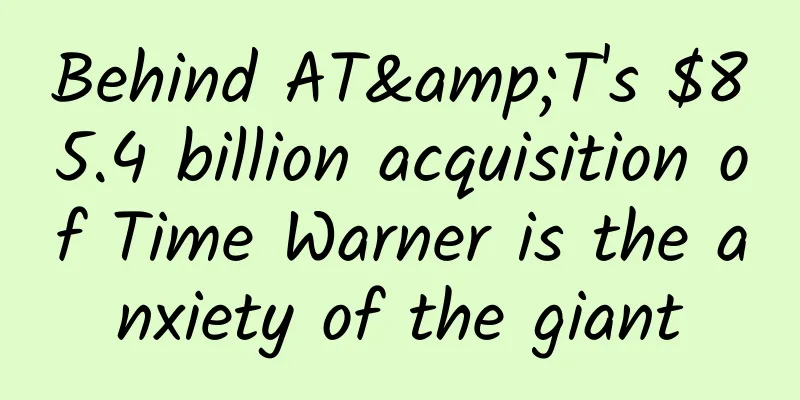Behind AT&T's $85.4 billion acquisition of Time Warner is the anxiety of the giant

|
American telecommunications giant AT&T and Time Warner jointly announced on the 22nd that the two parties have reached an acquisition agreement. The former will acquire the latter in the form of stock and cash at a price of US$107.5 per share. The total transaction amount will reach US$85.4 billion. This is a natural "hand-in-hand" for AT&T, a traditional telecom operator that is facing the pressure of business transformation amid fierce industry competition and mobile Internet changes in recent years, and is in urgent need of seeking new growth points. And for Time Warner, as a relatively pure content provider, it needs to find a "big tree" to maintain the high cost of content production and cope with the uncertainty of performance brought about by a relatively single revenue structure and changes in industry trends. Looking at the entire industry, the "grouping" of operators and content providers, which traditionally serve as distribution channels, has become a new trend. Three months ago, another telecom giant Verizon acquired Yahoo for US$4.8 billion , and a year ago it acquired America Online. Before acquiring Time Warner, AT&T also acquired the American satellite TV service provider DirecTV. From the $100 billion merger of Time Warner and AOL in 2000, to the bursting of the Internet bubble, to the advent of the mobile Internet wave, telecom and media giants have had to make business adjustments due to changes in user habits: people are spending less and less time in front of the TV and more and more time staring at their mobile phone screens; people no longer like to make phone calls or send text messages, but communicate through voice or text over the Internet; traditional news is no longer popular, and people are more willing to get information from social platforms. These changes have brought anxiety to the giants, and following the trend may be the only way to deal with these anxieties. Acquisition of Time Warner will accelerate AT&T's business transformation It is not difficult to see from the operating trends of AT&T in recent years that the growth of traditional operator business has stagnated, and AT&T urgently needs to expand new businesses to maintain the company's operating growth. In 2015, AT&T acquired DirecTV, a satellite TV service provider that focuses on broadcasting sports events in the United States, for $49 billion. The acquisition was a supplement to AT&T's traditional cable TV service business. After the acquisition, AT&T became the largest pay TV service provider in the United States and the world, covering 26 million users in the United States and 19 million users in Latin America. However, as more and more users choose to watch videos through online streaming, the traditional TV business is also challenged. In the more turbulent trend of consumers' "de-cable" activities, AT&T still needs to find new targets. After the acquisition of DirecTV, AT&T's 2015 financial report began to divide all business activities into four major segments: Business Solution, Entertainment Group, Consumer Mobility and International Business. Judging from these four major performance segments, business solutions for corporate users still account for the largest part of AT&T's operating performance, followed by consumer wireless business. The lowest proportion is the entertainment group, but judging from the situation reflected in the financial report, each business line has shown different development trends in recent years: the business solutions business, which occupies the largest business revenue, has been on a downward trend in revenue share since 2014, from 54% to 49%. Similarly, the proportion of consumer wireless business has also dropped from 28% to 24% during the same period, while the proportion of entertainment business has increased from 7% in 2014 to 17% in 2015. It is no exaggeration to say that judging from the financial report, AT&T, a telecom operator, is undergoing a business transformation, and the replacement of the old with the new is quietly taking place. The growth of traditional broadband and wireless businesses has slowed down or even stagnated, while the growth of emerging content businesses is accelerating. If AT&T's acquisition of Time Warner is successfully completed, it will mean that in the future AT&T's revenue from television and media services will account for 40% of its total revenue, which will be a fundamental business transformation for this traditional telecom operator. On the day the acquisition was announced, AT&T CEO Randell Stephenson said, "Premium content will always win, whether it's on the big screen, the TV screen or the mobile screen." It is not difficult to foresee that if the merger and acquisition transaction is finally completed, Time Warner's many high-quality content assets will be more reflected in AT&T's wireless business. While users obtain basic mobile services, they will also be able to obtain more value-added services at the content level. From a financial perspective, this massive $80 billion acquisition is costly for AT&T. The transaction was completed in the form of cash and stock. AT&T needs to raise part of the cash through debt. As of June this year, the company's long-term debt was $117.3 billion. The additional bonds issued for this acquisition will bring the long-term debt to $200 billion. In addition, the additional shares will bring AT&T more stock dividend costs, which are expected to be around $12 billion per year. Time Warner: Premium content assets still need to rely on big companies For Time Warner, this acquisition is both a success after years of transformation efforts and a helpless move under industry pressure. The most impressive thing about Time Warner is its merger with America Online in 2000. At that time, this was the largest merger and acquisition in history with a total amount of US$164 billion, but the result was not satisfactory. Affected by the bursting of the Internet bubble, the performance of the merged company instantly plummeted. In 2002, just one year after the acquisition was completed, AOL Time Warner suffered a record net loss of US$99 billion, and its market value shrank sharply from US$226 billion to US$20 billion. Jeffrey Bewkes, who took over as CEO of Time Warner in 2008, called this merger "the biggest mistake in the company's history." In the following eight years, Bewkes carried out drastic reforms on Time Warner, gradually divesting businesses such as AOL and Time Warner Cable, and focusing more on content provision. Today, Time Warner is no longer the giant media giant it was in the early years, but a producer of high-quality content. Time Warner owns CNN Cable News Network, TNT, HBO, Warner Bros. Film and Television Studios, etc. But like almost all content producers, Time Warner is also facing the dilemma of a single revenue structure dominated by advertising revenue and slow growth. In the past three years, Time Warner's net profit has almost zero growth. In the latest quarter, Time Warner's revenue even showed a year-on-year negative growth of 5%. In order to cope with this dilemma, under the leadership of Bewkes, Time Warner has also made extensive attempts in the fields of paid subscriptions and streaming media, based on the premise of high-quality content. For example, HBO Now is a specific measure taken by Time Warner in recent years to embrace the trend of more and more users playing video content through online streaming media. Currently, HBO NOW can provide content services to subscribing users through online TV platforms such as Amazon , Apple , Google , and Roku. Cooperation with these Internet giants has also greatly expanded the user base that HBO reaches. Time Warner's many high-quality content assets have also attracted a lot of attention in recent years. Two years ago, 21st Century Fox extended an olive branch to Time Warner and made an acquisition offer of $85 per share, but the acquisition was ultimately not completed. For this reason, Time Warner CEO Jeffrey Bewkes also suffered a lot of pressure from investors. In the past two years, in addition to continuing to focus on his content production business, finding better acquisition conditions for the company is also one of Bewkes' important tasks. Therefore, for both AT&T and Time Warner, this acquisition looks more like a "natural" partnership. For AT&T, it needs to complete the transformation from traditional telecommunications business to new media business by acquiring high-quality content. For Time Warner, it needs to rely on a bigger "backer" like AT&T to maintain the huge investment in content production and face the uncertainty of performance brought about by a single revenue model and industry changes. The anxiety of giants: seeking new business growth In fact, AT&T's acquisition of Time Warner is the latest example of the trend in recent years of the telecommunications industry entering the media field and expanding into content production business. AT&T's largest competitor in the United States, Verizon, has also made frequent moves in this field in recent years, the most recent of which was the acquisition of Yahoo for nearly US$5 billion. Verizon is in almost the same situation as AT&T: Verizon and AT&T are the first and second largest wireless operators in the United States respectively, each with hundreds of millions of wireless users and an absolute monopoly position. However, after this round of 4G network upgrades, the wireless operator businesses of the two giants do not have much room for growth, and some are even declining. In the third quarter, Verizon's revenue declined year-on-year, with a loss of 36,000 monthly mobile phone subscribers. In addition, in the Internet age, more and more people no longer watch TV, and the pay TV model of cable TV operators for many years is being subverted by Internet streaming videos that are more flexible and meet personalized customization needs. With the advent of the mobile Internet era, the charging model of operators has had to undergo a huge change, from focusing on voice and SMS services to focusing on data traffic charges. However, due to industry competition, operators also find it difficult to make money from data traffic charges. At the same time, the traditional business of wireless operators themselves is even being challenged by new entrants. Traditional cable TV service providers such as Comcast and Charter have plans to provide mobile wireless services, and Internet giant Google is also building its own wireless operating services. In such an environment of internal and external troubles, in order to seek new growth points in performance, the two giants have chosen to expand into the field of content production without exception. Whether it is a traditional TV content producer like Time Warner, or an Internet content provider like Yahoo and AOL, they actually reach the same goal through different paths. After the two major acquisitions of DirecTV and Time Warner, AT&T CEO Randall Stephenson's strategic intentions have become clearer. At an investor conference last month, he said, "Watching online TV video content with smart mobile devices is still in its early stages, but it will grow rapidly in the future." Therefore, it is not difficult to foresee that the high-quality video content of DirecTV and Time Warner will be more integrated with AT&T's consumer wireless business. In addition to the traditional wireless operator business, AT&T will be able to provide users with more value-added services. For Verizon, the two acquisitions of AOL and Yahoo are more intended to build online advertising business. Verizon has expressed its hope to stand on the same playing field with the two Internet giants Facebook and Google in the online advertising business. From the sky-high merger of Time Warner and AOL, to the bursting of the Internet bubble, to the arrival of the mobile Internet wave, industry trends have been constantly changing. For giants such as AT&T and Verizon, the only way to deal with it may be to follow the trend. These expensive acquisitions, which cost billions or even tens of billions of dollars, are the bets these giants are making for the future. As a winner of Toutiao's Qingyun Plan and Baijiahao's Bai+ Plan, the 2019 Baidu Digital Author of the Year, the Baijiahao's Most Popular Author in the Technology Field, the 2019 Sogou Technology and Culture Author, and the 2021 Baijiahao Quarterly Influential Creator, he has won many awards, including the 2013 Sohu Best Industry Media Person, the 2015 China New Media Entrepreneurship Competition Beijing Third Place, the 2015 Guangmang Experience Award, the 2015 China New Media Entrepreneurship Competition Finals Third Place, and the 2018 Baidu Dynamic Annual Powerful Celebrity. |
<<: I didn’t expect that autonomous driving would affect the motorcycle business
>>: Tesla's free charging service will end next year and will be replaced by a points-based system
Recommend
How to arouse users’ interest in 15 seconds?
Suppose your company is holding a food tasting ev...
The secrets of Douyin App's operation and promotion routines
The reason why Douyin is so popular is not only b...
Dadong's "Tik Tok Short Video Local Account Tutorial" has a concise lesson and no nonsense
Training course video lecture content introductio...
Android 9.0 will ban developers from using unofficial APIs
According to the developer forum XDA, a recent su...
Xiaomi valuation topic: Please learn how to do public relations from Lei Jun
Generally speaking, companies that hype valuation...
Representatives suggest: Substantially reduce WeChat payment fees
[[384746]] Regardless of the field, handling fees...
When will the 20th National Congress of the Communist Party of China be held? How often is the Party’s National Congress held?
The National Congress of the Communist Party of C...
How to guide users to create content from 0 to 1?
1. What did Lukou Community do from 0 to 1? Lukou...
360, which is not short of money: Will it be the next video overlord?
After years of market cultivation and capital ope...
Smart TV ecosystem has diversified gameplay: LeTV gradually becomes the industry benchmark
The battle for the "smart TV ecosystem"...
Ex situ conservation protects our elk from getting lost
Produced by: Science Popularization China Produce...
Advertising strategies of Xiaohongshu and Bilibili
Without further ado, let’s get straight to the po...
Can clothes cause cancer? Carcinogens that are easily overlooked in daily life
Recently, the State Administration for Market Reg...
How to conceive a planning proposal in a clear and organized manner?
I have heard many of my friends and colleagues ta...









